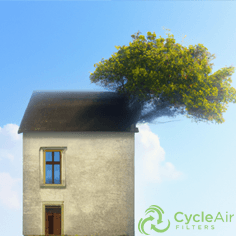
Comparing the household energy consumption of furnaces, heat pumps, mini-splits, and other HVAC
| Scott C
Heating, ventilation, and air conditioning (HVAC) systems are an essential part of any home or building. They help to keep us comfortable and healthy by providing us with clean and conditioned air. However, HVAC systems can also be a significant source of energy consumption. Today at Cycle Air we will explore the different types of HVAC equipment and their energy consumption to help you make informed choices when it comes to your HVAC system.
- Furnaces: Furnaces are the most common type of heating equipment used in homes and buildings. They can be powered by electricity, natural gas, propane, or oil, and they come in a variety of efficiency ratings. The most efficient furnaces have an Annual Fuel Utilization Efficiency (AFUE) rating of at least 90%, which means that 90% of the fuel used by the furnace is converted into heat. Furnaces use an air filter placed in a dedicated slot within the ductwork return that acts to keep dust off of the blower fan to maintain optimal performance and energy use, while having an added benefit of purifying indoor air. Choosing an option like Cycle Air Filters optimizes airflow for an energy efficient furnace.
- Boilers: Boilers are another type of heating equipment that are commonly used in homes and buildings. They are powered by natural gas, propane, or oil and come in a variety of efficiency ratings. The most efficient boilers have a Annual Fuel Utilization Efficiency (AFUE) rating of at least 90%. Boilers are considered more efficient than furnaces in terms of heat distribution, especially in buildings with multiple floors.
- Heat Pumps: Heat pumps are a type of HVAC equipment that can be used for both heating and cooling. They work by transferring heat from one place to another, instead of generating heat themselves. They are considered to be more energy-efficient than furnaces and boilers, with a coefficient of performance (COP) of around 3-4. It means that for each unit of electricity used to power the heat pump, 3-4 units of heat are generated.
- Mini-splits: Mini-splits are a type of HVAC equipment that consist of an outdoor unit and one or more indoor units. They are very energy-efficient, with a Seasonal Energy Efficiency Ratio (SEER) of around 20. They are also a good option for buildings with limited space for HVAC equipment, since the outdoor and indoor units can be located in different areas of the building.
- Geothermal Systems: Geothermal systems are a type of HVAC equipment that use the Earth's constant temperature to heat and cool buildings. They are considered to be the most energy-efficient of all HVAC systems, with a COP of around 4-6, and they can also provide hot water. They require significant upfront investment, but they are known to save a lot of energy over their lifespan, and often qualify for different kinds of incentives or tax reductions.
In conclusion, there are a variety of HVAC equipment options available, each with its own energy consumption. By understanding the energy consumption of different types of HVAC equipment, you can make an informed decision when it comes to your HVAC system. Factors like the size of your building, your budget, and your energy consumption goals should be taken into account when making your decision. Keep in mind that the most efficient option is not always the best option for your specific needs, working with a HVAC professional can help you to find the right balance.

1 comments to
Very interesting and helpful article in deciding on which HVAC system to install especially in a new build. Over the years I have found that regular maintenance, esp keeping the filter clean, has aided in extending the lifecycle of your HVAC unit.